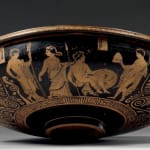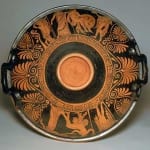Apulian Red-Figured Patera, 365 BCE - 355 BCE
Terracotta
height 40 cm
height 15 3/4 in
height 15 3/4 in
X.0104
Further images
The Greek colonies of southern Italy (known in antiquity as Magna Grecia) were marked by their initial allegiance to the ceramic styles of the Attic mainland. However, over the years,...
The Greek colonies of southern Italy (known in antiquity as Magna Grecia) were marked by their initial allegiance to the ceramic styles of the Attic mainland. However, over the years, native traditions and innovations heavily influenced the works of Magna Grecian potters. Unorthodox forms and painting-styles were seamlessly merged with the standard Greek style, creating distinctive works of art unique to the Hellenistic world. This Apulian red-figure patera features serpentine handles decorated with applied rosette patterns to facilitate transportation of this piece. A patera was a type of large platter used for presenting and serving food to guests during elegant diner parties. The dish rests on a low foot-ring and features painted details added in white and brown wash. While the focus would have been on the interior of the patera, the exterior has received most of the attention for the decorative scheme. Painted on one side of the exterior, a seated nude youth holds a shield and a spear, his sword resting at his side. He is flanked on the left by a youth holding spears and a woman holding a phiale (a type cup used for offering libations) and on the right by a youth carrying spears and a helmet. Two windows have been added to the otherwise black background space, suggesting that this scene takes place indoors, or perhaps directly outside of a structure. The other side of the patera shows a thyrsos-bearing youth holding a phiale. A standing youth and a girl flank him on either side. Palmette motifs so typical of Magna Grecian art fill the space around the handles, leaving almost no space on the exterior of the patera unadorned. The scholar A.D. Trendall attributed this patera to the Painter of Athens 1714 in his book on Apulian Vases.
Published: A.D. Trendall and A. Cambitoglou, The Red-figured Vases of Apulia, 2nd Supplement, Part I. London, 1991. p. 51, no. 8/167a .
Exhibited: Dallas Museum of Art (loan no. 7.1995); San Antonio Museum of Art, July 1997 to March 2003.
Published: A.D. Trendall and A. Cambitoglou, The Red-figured Vases of Apulia, 2nd Supplement, Part I. London, 1991. p. 51, no. 8/167a .
Exhibited: Dallas Museum of Art (loan no. 7.1995); San Antonio Museum of Art, July 1997 to March 2003.







